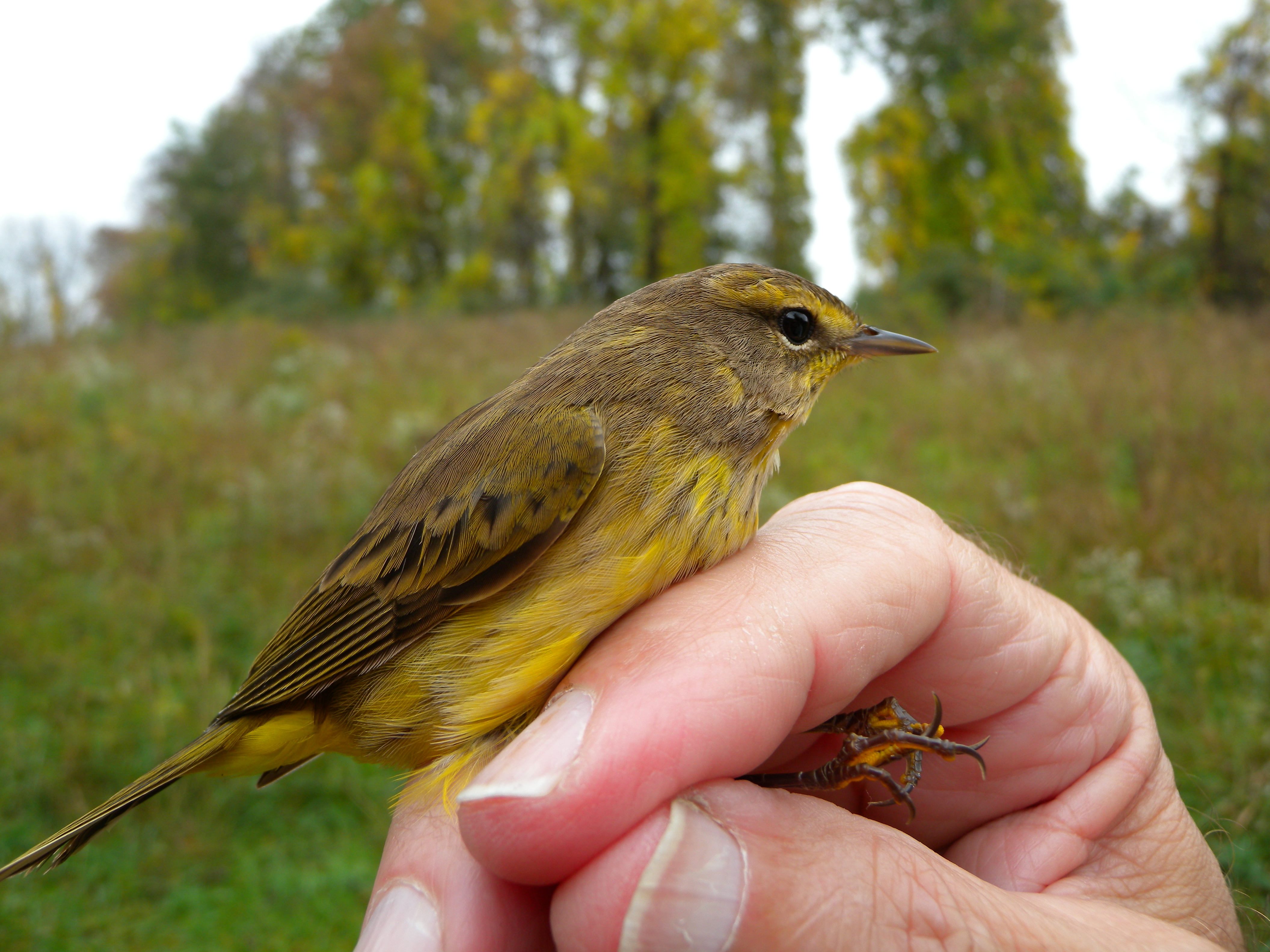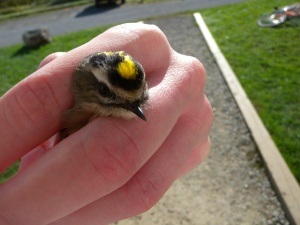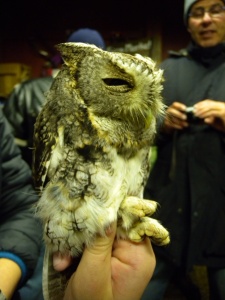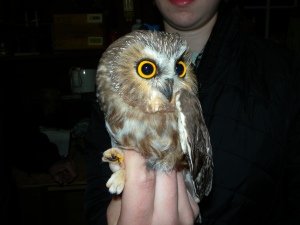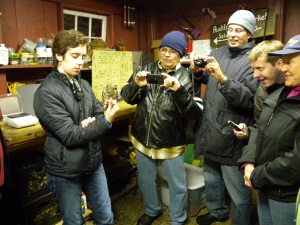
I haven’t brought you up to date on last week or this week yet because it has been pretty hectic for us sleep-deprived, cranky bird banders. This is the time when we are working hard banding back to back: nights for Saw-whet Owls and mornings for the last fall songbird migrants. This sounds crazy, I know; why don’t we just quit the songbird banding and focus on the owls? The reason is because it is very important to gather as much songbird data as we can up until the very end when the flight peeters out so as to flesh out the entire picture of the fall migration. Quitting songbird banding too early could mean we miss the unexpected migrants on the periphery of the fall movement. So we soldier on for the love of birds and the loyalty of scientific research.

We went for songbirds last Tuesday (10-25) and Wednesday (10-26) morning and were surprised by large numbers of migrants still moving through. We banded 59 birds on Tuesday, including a feeding flock of snarly Chickadees and Tufted Titmouse. Wednesday was the notable fallout day, with migrant birds virtually dripping from the trees and carpeting the fields; the hedgerows were alive! A large flock of Cedar Waxwings eluded us all morning by staying high in the canopy, but we banded 70 birds that day, including a late Nashville Warbler, several Yellow-rumped Warblers, lots of White-throated Sparrows, a handful of lovely little pink-billed Field Sparrows, a flock of young Hermit Thrush, and the first batch of Dark-eyed Juncos of this year! It was good to see the Juncos again… to hear their familiar metallic chipping in the shrubs, and to watch the flash of white outer tail feathers as they jovially flit about the hedgerow….almost like welcoming old friends back for the holidays. Of course, Juncos are the first sign of impending snow, and they indeed brought the snow with them.


Perhaps last Wednesday was so busy because all the birds knew they had to get a move on before the rain of last Thursday and the snow of Saturday. In the calm before the storm they can feel the pressure changing and thus sense what is to come. In any case, Wednesday was a day to be remembered.
I went home briefly for lunch after morning banding and stepped out of my car in my driveway to a birder’s paradise. There were birds EVERYWHERE. I think I left the keys in the ignition with the car running and the door wide open as I grabbed my binoculars from the dashboard and excitedly scanned the yard. A Brown Creeper was creeping 5 feet away from me in a magnolia tree, and a Ruby-crowned Kinglet was flitting around hunting insects in an ornamental tree 2 feet in front of me. Further into the yard was a Hermit Thrush distinctively bobbing its tail up and down under the blue spruce. Suddenly a woodpecker whizzed past the spruce and into the arborvitae next to the house. Could it be? It was! A beautiful male Yellow Bellied Sapsucker, only seen in my yard during migration! I ventured further into the shallow woods behind my house, lured by the restless flurry of birds. There I saw about 20 Robins, the Hermit Thrush (which followed me and was spying on me as I find they often do), an abundance of Yellow-rumped Warblers, a Golden-crowned Kinglet, lots of White-throated Sparrows, and yet another Yellow-bellied Sapsucker (a juvenile) tap tap tapping on an oak. What a day!
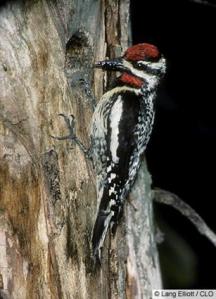

Speaking of Golden-crowned Kinglets, on that same Wednesday (10-26) we had an interesting catch, if you can fairly call it a catch. Lisa, Lou, Doris and I were about to disperse for another net run when a little Golden-Crowned Kinglet came careening into the banding lodge and flew up into the skylight. She didn’t have enough speed to injure herself fatally because in order to hit the skylight she had to dip down and then up. However, she did bump her head unexpectedly and then sat on the railing totally stunned. I saw the whole transaction and am still not sure who was more stunned: me or the bird. As Lisa and I were standing there staring at the bird in disbelief, Doris quickly reacted and said, “Grab it and band it!” Lisa and I looked at each other in shock and then looked at the bird. She seemed okay, so I gently picked her up and banded her. She perked up and flew away after we processed her, but she didn’t fly far. We saw her perched in a tree 5 feet away looking at the banding shelter and then at her ankle as if thinking, “What on earth just happened to me? One minute I was flying and the next I was stopped by an invisible wall and then picked up by a giant who stuck this shiny thing on my ankle!” She got over it fast and soon went back to foraging.

That day, we also got a recap White-throated Sparrow, which was exciting because the band looked like an old band. Getting a recapture songbird from someplace else is very unusual; most all the recaps that we get are our own birds that we banded just a few days ago at Rushton (they either haven’t moved on yet or are here to stay). This White-throated Sparrow ended up being our own as well. However, looking back at the records, Doris discovered that it was first banded at Rushton as an After Hatching Year (AHY) bird in December of 2009. This means the bird is over 3 years old and probably spends its winter in Rushton Woods Preserve every year! Interesting example of winter site fidelity.

Yesterday (11/2) was pretty slow for songbird banding, with only 34 birds, which is probably how it will be from here on out as fall migration comes to a close. Tuesday (11/1) yielded 58 birds including a gorgeous male Golden- crowned Kinglet, an exquisite Brown Creeper, the first handsome Fox Sparrow of the season, and a bizarre White-throated Sparrow with bright orange lores instead of the usual yellow (referring to the area right in front of the eyes). There are still Palm Warblers moving through the area in decent numbers as well; they were at Rushton yesterday, and I saw one at Okehocking on Sunday while walking in the snow with my pug. Next week will most likely be the last week of songbird banding before we close for the season. As always, you’re welcome to come out and observe Tuesday and Thursday.

As for the Northern Saw-whet Owl (NSWO) banding, the season is well underway. We are going out every night this week to take advantage of the peak of the season and the relatively dark nights before the full moon thwarts our efforts next week. (Moonlit nights are not good for catching NSWO because they can see the nets better and tend to move less because they know they are more visible to predators like Great Horned Owls, Screech Owls, and Barred Owls.)

I believe our total for this season so far is 23 Saw-whets. The season started out a couple of weeks ago with a very slow trickle of none, 1, or 2 owls a night until All Hallow’s Eve when we got 7 ferocious Halloween NSWOs. They were especially feisty that night with talons flailing and beaks clapping…maybe they knew it was the Devil’s night! Tuesday night (11/1) we got 8 Saw-whet owls including a recapture banded a few nights ago by us. Last night, we banded 4 new Saw-whets. This week we also banded a gorgeous red-phase Eastern Screech Owl, which brings our screech total of this season to 4 (3 red and one gray). Screech Owls can be predators to Northern Saw-whet Owls, but so far (knock on wood) our resident Screeches have been behaving themselves. We enjoyed hearing them singing last night amidst the meowing contact calls of the Saw-whets in the hedgerows.


All of the other Saw-whet banding stations nearby are starting to get the owls in greater numbers as well, but no one is seeing the abundance of last year. Even Scott Weidensaul’s 3 stations near Schuylkill Haven, PA (“the Big Boys”) have only about 31 owls as of November 1, which is slightly behind their worst season in 2006, when they had 33 for the date, and well below their 10-year average of 64 for the date. This year is definitely not an irruption year for the little fuzzballs. Perhaps there are too many rodents up north to warrant many of the owls to migrate south or perhaps the breeding owls were not as successful this summer.
In any case, this is shaping out to be the best week this year so far for migrant Saw-whets to reach Rushton and jump into our nets. If you would like to observe the mistnetting and banding process of these wondrous little creatures of the night, remember that you must contact Lisa Kiziuk first (lkr@wctrust.org) to make an owl appointment. Nights are getting frigid so layer up!
Please note that this Friday (Nov 4th) is the PA Young Birder meeting at Rushton from 7-9pm, so owl banding will be closed to the public during that time, unless you have RSVPed your child for the event. The night should be a wild one, with Saw-whet Owl banding and presentations, owl ‘Seek and Find’ in the farmshed, owl art with Adrian Binns, s’mores and owl stories around the bonfire, and even short night hikes for those brave souls that really want to get a feel for the natural world at night!
There’s a lot going on in the woods,
~Blake
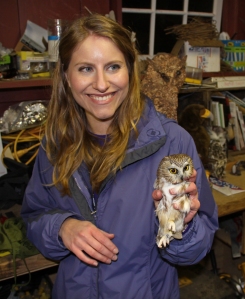
P.S. Our bird conservation program has really taken flight this past year, and we love being able to connect the public with our birds in such an intimate way. The Willistown Conservation Trust’s main goal remains protecting the land we love, but we have found that birds (in addition to farm fresh food) are a great way to get people to appreciate the land on a deeper level. Furthermore, our bird banding research contributes to global bird conservation efforts while guiding local habitat management for the benefit of birds and other wildlife. We appreciate all the help we can get as we are a non-profit organization with big dreams! If you have benefitted in some way from any of our programs or if we have provided you with a life-changing moment with one of our wild birds, please consider giving back. Anything helps!



